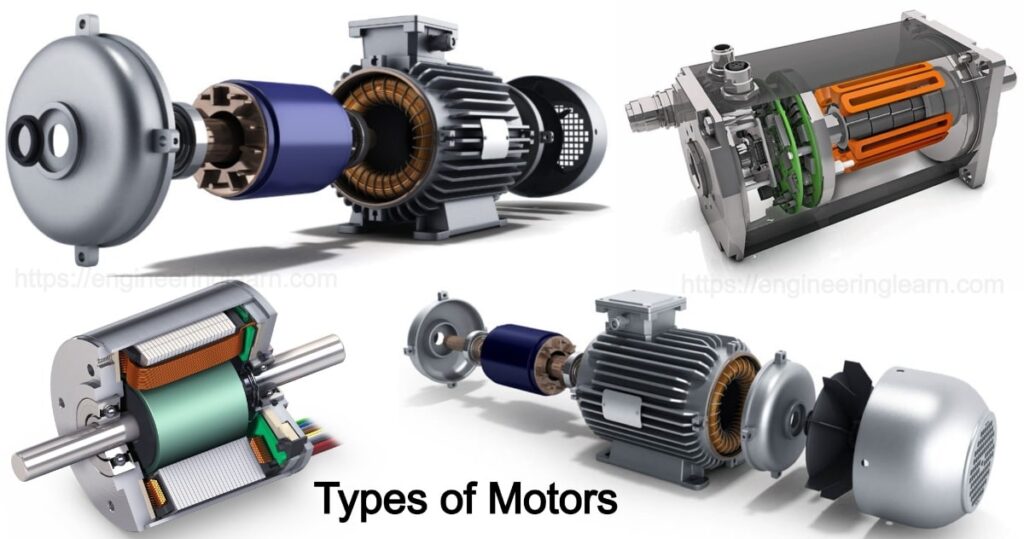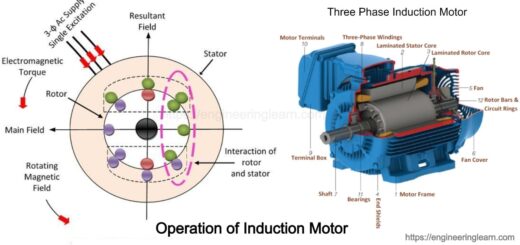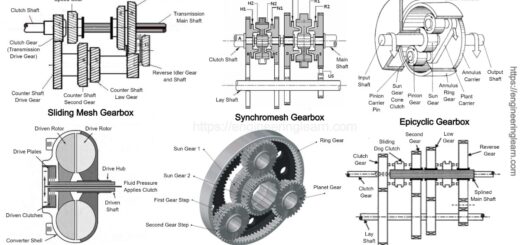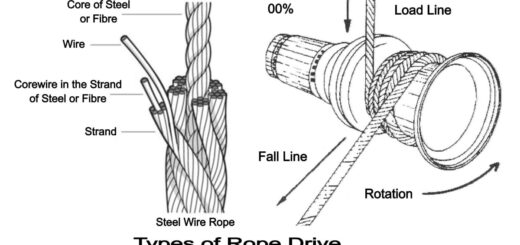6 Types of Motors and Their Use [Complete Details]

Types of Motors And their use :- Motor are classified into following categories,
Different Types of Motors
Types of DC Motors
- D.C Shunt Motor
- D.C Series Motor
- Self Excited D.C Motor
Types of AC Motors
- Synchronous motor
- Induction motor
1. DC Shunt Motor: ( Types of Motors )
In a D.C shunt motor torque is directly proportional to the current. In contrast for series wound D.C motor torque increases as the square of armature current. D.C motor to provide high start-up torque and high start-up loads.
Uses for D.C Motor:- D.C motor of shunt type having self regulating capabilities theses D.C shunt motor are ideal for various operation where precise control is required. They don’t provide high initial torque, So there is initial torque small.
D.C shunt motor includes machine tools such as lathes & grinders or industrial application that includes fans & compressors.
2. DC Series Motor: ( Types of Motors )
This is similar to any other motor because main function of the motor is to convert the electrical energy into mechanical energy. D.C series motor operates on the principle of electromagnetic, whenever a magnetic field is formed approximately current carrying conductor cooperates with an exterior magnetic field, thus rotating motion can be generated.
Components of D.C series motor: rotor, commutator, stator, axle, field winding.
3. Self Excited D.C Motor: ( Types of Motors )
Motor in which current to the field winding or coils can be energized by a motor itself. In self excited D.C motor, the field coils may be connected parallel to the armature in the series or it may be partly connected in series & partly in parallel with armature winding.
4. Synchronous Motor: ( Types of Motors )
Synchronous term comes from the speed of the rotor of the motor is same as rotating magnetic field. These motor are fixed speed motor, the speed is synchronized by the frequency. Synchronous motor requires external source to start(not self starting). Synchronous motors having unique characteristic of operate under any electrical power factor. This is used in electrical power factor improvement.
Principle of Synchronous Motor:- Synchronous are double excited machine i.e. two electrical inputs needed for safe operation. It’s stator winding that consist of 3 phase supply to 3 phase stator winding & D.C to rotor winding.
5. Induction Motor: ( Types of Motors )
Induction motors are optimal for unidirectional & continuous operation.(i.e. conveyor system). Induction motors are operated by plug the motor into A.C supply, thus motor can be easily operated.
Configuration & Components of Induction Motor
- Parallel shaft, right angle solid shaft, Right angle hollow gear types
- Electromagnetic break available.
- Round shaft ( no gear Types)
- Inverters sold separately.
Induction motor mainly consist of flange bracket, stator, motor case, output shaft, ball bearing, lead wires, Painting.
6. Special Purpose Motor: ( Types of Motors )
Stepper motor basics:- as although other electric motor, stepper motor having a stationary part (stator), rotational part (rotor), on rotor there are teeth on which coil are wired while the rotor is permanent magnet or rotor, variable reluctance iron core.
Basic Principle:- energizing one or more rotor phase, a magnetic field is formed when current is flowing in coil , rotor or magnetic field
Application of Special Motor
Due to their properties they are used where a simple position to control, ability to hold a position are including:
ATM machine: bill movement tray elevator, robot arms- end effectors, 3D printers, DSLR camera- aperture/ focus regulation.













